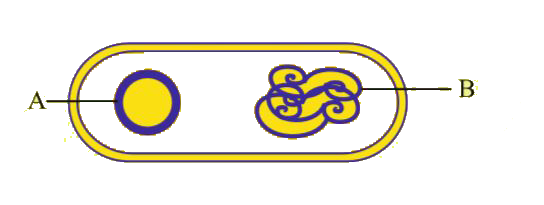What is rDNA?
Step-by-Step Text Solution for the Question: What is rDNA?
1. Definition of rDNA:
- rDNA stands for recombinant DNA. It refers to DNA molecules that have been artificially created in a laboratory through the process of genetic recombination.
2. Understanding Genetic Recombination:
- Genetic recombination is the process by which genes from one organism are transferred to another organism. This can involve the insertion of desired genes into a DNA molecule using artificial methods.
3. Role of Genetic Engineering:
- The creation of rDNA is a key aspect of genetic engineering. This field of biotechnology focuses on manipulating DNA to create new genetic combinations that can lead to desired traits or functions in organisms.
4. Formation of rDNA:
- rDNA is formed by combining two or more DNA fragments. These fragments can come from different biological sources, allowing for the introduction of new traits or characteristics into an organism.
5. Methods of Creating rDNA:
- There are several methods used to create rDNA, including:
- Transformation: This involves the uptake of foreign DNA by a cell.
- Phage Introduction: This method uses bacteriophages (viruses that infect bacteria) to introduce new DNA into a host organism.
6. Goals of rDNA Technology:
- The primary goals of rDNA technology include:
- Isolation and characterization of specific genes.
- Modification of desired genes to enhance their functions.
- Artificial synthesis of new genes.
- Modification of an organism's genome to introduce new traits.
- Enhancement of the human genome for various applications.
- rDNA stands for recombinant DNA. It refers to DNA molecules that have been artificially created in a laboratory through the process of genetic recombination.
- Genetic recombination is the process by which genes from one organism are transferred to another organism. This can involve the insertion of desired genes into a DNA molecule using artificial methods.
- The creation of rDNA is a key aspect of genetic engineering. This field of biotechnology focuses on manipulating DNA to create new genetic combinations that can lead to desired traits or functions in organisms.
- rDNA is formed by combining two or more DNA fragments. These fragments can come from different biological sources, allowing for the introduction of new traits or characteristics into an organism.
- There are several methods used to create rDNA, including:
- Transformation: This involves the uptake of foreign DNA by a cell.
- Phage Introduction: This method uses bacteriophages (viruses that infect bacteria) to introduce new DNA into a host organism.
- The primary goals of rDNA technology include:
- Isolation and characterization of specific genes.
- Modification of desired genes to enhance their functions.
- Artificial synthesis of new genes.
- Modification of an organism's genome to introduce new traits.
- Enhancement of the human genome for various applications.
Topper's Solved these Questions
- BIOTECHNOLOGY : PRINCIPLES AND PROCESSES BOOK - MODERN PUBLICATIONCHAPTER - BIOTECHNOLOGY : PRINCIPLES AND PROCESSES EXERCISE - Chapter Practice Test ( Section-C)
4 Videos
- BIOTECHNOLOGY : PRINCIPLES AND PROCESSES BOOK - MODERN PUBLICATIONCHAPTER - BIOTECHNOLOGY : PRINCIPLES AND PROCESSES EXERCISE - Chapter Practice Test ( Section-D)
1 Videos
- BIOTECHNOLOGY : PRINCIPLES AND PROCESSES BOOK - MODERN PUBLICATIONCHAPTER - BIOTECHNOLOGY : PRINCIPLES AND PROCESSES EXERCISE - Chapter Practice Test ( Section-A)
6 Videos
- BIOTECHNOLOGY AND ITS APPLICATIONSBOOK - MODERN PUBLICATIONCHAPTER - BIOTECHNOLOGY AND ITS APPLICATIONSEXERCISE - CHAPTER PRACTICE TEST (SECTION - E)
2 Videos
Similar Questions
Knowledge Check
Recombinant DNA (rDNA) tenchnology is related with
AC.darwinBStanley CohenCHerbert BoyerDBoth (b) and (c)The correct sequence of steps in rDNA technology is
AIsolation of DNA → Fragmentation → Isolation of desired DNA → Ligation Transferring → Culturing → ExtractionBIsolation of desired DNA → Fragmentation → Isoligation of DNA → Culturing → Ligation → Transferring → ExtractionCIsolation of desired DNA → Culturing → Fragmentation → Isolation of DNA → Ligation → Transferring → ExtractionDIsolation of DNA → Fragmentation → Culturing → Isolation of desired DNA → Transferring → Ligation → ExtractionWho discovered recombinant DNA (rDNA) technology?
AHar Gobind KhoranaBJamesCStanley Cohen and Herbert BoyerDWalter Sutton and Avery
What is Energy? What are different types of energy? What are different forms of energy?
View SolutionWhat is the basic aim of rDNA technology?
View SolutionWhat' is genetic engineering List the steps in rDNA technology.
View Solution(B) Also ,mention the use of part'A' in rDNA technology.

View SolutionWho discovered recombinant DNA (rDNA) technology?
View Solution
